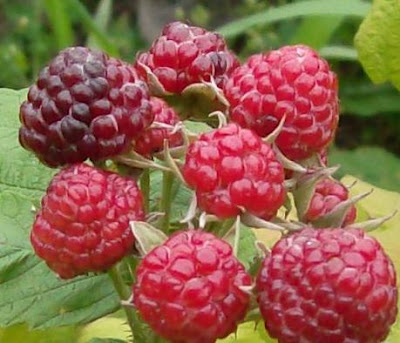 While wandering through field, stream, woods, and mountainside, I would gather handfuls of different plants. After researching to be sure of their identity and properties, they would be dried on a screen and added to a large glass jar.
While wandering through field, stream, woods, and mountainside, I would gather handfuls of different plants. After researching to be sure of their identity and properties, they would be dried on a screen and added to a large glass jar.Now this particular jar of tea was truly wonderful. There were the usual suspects, of course ….peppermint, chamomile, and leaves from strawberry and red raspberry.
 As the herb garden grew, a few leaves of sage, a sprig or two of thyme, basil, rosemary, lemon balm, lemon verbena, and comfrey found their way into the jar. Violets and their foliage went in, as did the beautiful wild roses, elderflower and honeysuckle blossoms. As the bee balm began to bloom, a few heads were dried for the tea jar. Dried nettles and cleavers and Echinacea leaves became part of the tea, and then some wonderful spices – star anise, ginger root, cardamom seed, cinnamon bark.
As the herb garden grew, a few leaves of sage, a sprig or two of thyme, basil, rosemary, lemon balm, lemon verbena, and comfrey found their way into the jar. Violets and their foliage went in, as did the beautiful wild roses, elderflower and honeysuckle blossoms. As the bee balm began to bloom, a few heads were dried for the tea jar. Dried nettles and cleavers and Echinacea leaves became part of the tea, and then some wonderful spices – star anise, ginger root, cardamom seed, cinnamon bark.  Mid summer, raspberries, elderberries and blueberries were added along with gooseberry leaves. In the late part of the summer, I found and added rose hips.
Mid summer, raspberries, elderberries and blueberries were added along with gooseberry leaves. In the late part of the summer, I found and added rose hips.Eventually I wound up with a gallon jar of really gorgeous dried botanicals. Each cup was completely different- in color, flavor, and scent. We had stevia and licorice root sticks on hand for sweetening, and for that winter, friends visiting our home would look forward to a cup of that special tea – always a surprise, always delicious.
It was great fun creating that blend, and it was also a time of learning. By the end of that year, it was clear that it is very difficult to make a bad cup of herbal tea, and “simple” to make a fabulous blend.

The purpose of telling this story is to encourage you to try making some blends of your own. Making teas with herbs has always been a part of the human culture. The folkloric use of herb teas is easy to find, and in this part of the country, still passed on from mother to daughter. Peppermint tea for upset stomachs, catnip and fennel to help the nursing mother, valerian root tea for sleeplessness, horehound or mullein for coughs, feverfew for migraines, sage tea for night sweats, ginger tea for morning sickness, slippery elm bark or marshmallow root for any digestive problem from lips to anus, chamomile for just about anything, St. John’s wort for the blues, and the list goes on and on.
 We used these plants for centuries. Now there are warnings and issues of drug interactions and this or that might be a carcinogen. Comfrey is a wonderful healing plant, but it is labeled as dangerous – the active ingredient allantoin may cause tumors in lab rats if taken in huge quantities. Ephedra was almost magical in helping people with asthma, but it has now been removed from shelves because some people used it to create an amphetamine-like product. Kava will probably be next. St John’s wort is hanging in there for now, but use is discouraged because it will interact with some pharmaceuticals. So does grapefruit, by the way….. Our advice? Use all things in moderation.
We used these plants for centuries. Now there are warnings and issues of drug interactions and this or that might be a carcinogen. Comfrey is a wonderful healing plant, but it is labeled as dangerous – the active ingredient allantoin may cause tumors in lab rats if taken in huge quantities. Ephedra was almost magical in helping people with asthma, but it has now been removed from shelves because some people used it to create an amphetamine-like product. Kava will probably be next. St John’s wort is hanging in there for now, but use is discouraged because it will interact with some pharmaceuticals. So does grapefruit, by the way….. Our advice? Use all things in moderation.This article is an excerpt from:
 available from The Essential Herbal website, under "Books" and it was written by yours truly.
available from The Essential Herbal website, under "Books" and it was written by yours truly.
No comments :
Post a Comment